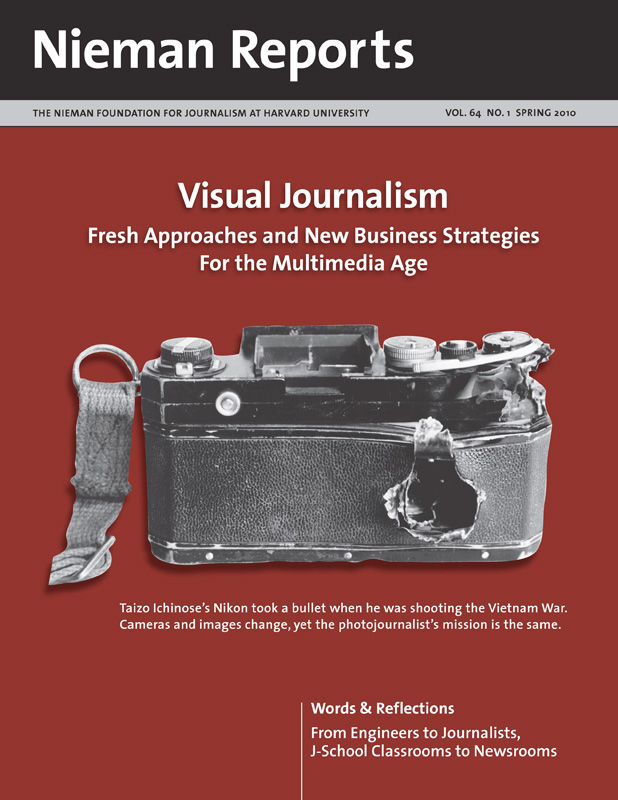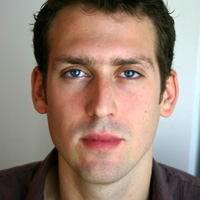RELATED ARTICLE
“Pakistan: A Freelancer as Photographer”
– Iason AthanasiadisIn 2007 as I left Tehran after three tumultuous years of living there to become a Nieman Fellow, funding for photojournalism was collapsing. I was trying to understand how non-native English speakers could tell visual stories by accentuating the characters’ own voices and the natural sounds of their surroundings. The word “multimedia” was being bandied about but assignments still seemed to be envisioned with a strict separation between articles and photography.
In a very short time, that church-and-state separation evaporated, as did news organizations’ budgets. When I returned to work in 2008, I noticed that photographers were abandoning the profession. Staff photographers were out of work and editors increasingly relied on the abundant and cheap supply of man-on-the-street photographs. With foreign reporting, the news is even worse. In the past three years, I’ve set out for North Korea, Libya and Pakistan with editors willing only to “take a look at what you come back with.”
In these tough times, there are glimmers of hope. Jon Sawyer, a veteran foreign correspondent, directs the Pulitzer Center on Crisis Reporting in Washington, D.C., which is one of several Web-based, foundation-supported efforts that now offer financial assistance for foreign reporting. Journalists can apply for travel grants that enable them to produce the kind of foreign news reporting that many news organizations no longer support. In 2009, a multimedia Web site about living with HIV/AIDS in Jamaica whose work the Pulitzer Center sponsored through a grant, was awarded an Emmy and the Pulitzer Center itself, was recognized by the National Press Foundation with an award for Excellence in Online Journalism.
By receiving grants from the Pulitzer Center, I was able to spend time in Turkey chronicling its rise as an emerging power, to report on the social turmoil that preceded Greece’s economic decline, and to document the crisis in Iran sparked by the presidential elections. For a struggling freelancer, these grants—combined with my ability to share this reporting with online news outlets such as GlobalPost—give me a lifeline to continue my work as a photojournalist.
New Visual Venues
There have been times in recent years when I have despaired of being able to earn my living doing photojournalism. Even though my student visa gave me the privilege of being able to travel in Iran’s interior and I had the advantage of speaking Persian and Arabic and thus could gain access to insiders’ stories with an outsider’s fresh approach, assignments were not forthcoming. I faced similar circumstances when I was in places where news was happening and no news organization seemed interested in paying for photographs. I traveled in northern Afghanistan during the 2005 parliamentary elections and I was in Lebanon for the aftermath of the 2006 war with Israel. In 2007 I made an overland crossing from Iran into Iraq. Each of these reporting trips involved personal expense and considerable risk. At the peak of Iraq’s pre-surge violence, I embedded with the U.S. Army in Baquba, a city echoing with mortars and suicide bombs. When I returned to Tehran, a comparable haven of harmony, Mahmoud Ahmadinejad’s wary new government was pressuring foreign correspondents to leave by revoking the last accreditations that its more moderate predecessor had granted.
Feeling this pressure, I turned to art photography. At that time Tehran was buzzing with artists pushing the boundaries of what Iranian officials deemed permissible. Iranians love photography. Even more, they wanted to know how a foreigner living among them saw them in this time and place. In the three photography shows I did in my three years in Tehran, I was censored just once, not unpredictably at the state-run House of Artists where the director asked me to remove images that he judged could be interpreted as insulting the regime.
“If an Iranian photographer put these on show, no one would bat an eyelash,” the director told me. The two pictures were of a bombed-out Iraqi tank with the words “Death to Israel” spray painted on it in Persian and an exhausted-looking salesman standing under two propaganda posters depicting ideologically vigorous “martyrs” from the Iran-Iraq War. “But when a foreigner presents them in an Iranian gallery, everyone starts to wonder what he’s trying to say,” he said.
Every day, I visited the gallery where I’d hear the views expressed by a wide cross section of society—from uptown North Tehranis, chador-wrapped university graduates, and soldiers who came from a nearby barracks either to look at the art or at the gallery’s attractive female patrons. What they thought of how my photographs represented Iranian society fascinated me, as did their attempts to understand why I was in Iran.
By taking this new approach to my photography, I had the opportunity to get to know well an emerging generation of talented Iranian photographers, such as Getty Images’ Majid Saeedi, United Press International’s Mohammad Kheirkhah, and Yalda Moaiery. They’d come often to these galleries, proudly carrying their expensive cameras and lenses. As they shared their work with me, I could see that their photography exhibited the eye for detail that had won Iranian filmmakers numerous awards in foreign film festivals. Of course I had no idea then that in the summer of 2009 these photographers would capture extraordinary images of the post-election street unrest and send their images overseas. Several of them spent time in jail or were forced to flee the country as the authorities made criminal the act of photographing opposition crowds.
Once I was in the United States I did what I could to raise awareness about the facets of Iranian society that American audiences aren’t seeing through the news media. In Los Angeles, where one of Iran’s largest diaspora communities resides, the Craft and Folk Art Museum helped me by creating an educational program about contemporary Iran that transcended the photographs I displayed as part of this project. In Washington, D.C., the Woodrow Wilson Center opened its doors to another photography show that focused on Iran’s youth as a way to convey their unheard voices.
RELATED ARTICLES
“A Photojournalist Immerses Himself in the Story Being Told”
“Peering Inside Contemporary Iran”
“Understanding Iran: Reporters Who Do Are Exiled, Pressured or Jailed”
– Iason AthanasiadisIn my photographs, I have been able to portray the tensions and frustrations that had been brewing in Iran for years. When Iran’s Ministry of Intelligence arrested me after I returned to Tehran as a photojournalist to report on June&
rsquo;s post-election unrest, one of my prison interrogators pointed to my Washington, D.C. exhibit as an event designed to pave the way for the soft overthrow of Iran. I took what he said as a backhanded compliment.
The enormous changes rattling our industry are forcing those of us who use visual media to find new approaches to telling stories. Whether our work finds its audiences on the walls of galleries and museums or on Web sites where foreign news is finding renewal, the challenge for us will be in finding the kind of support—financial and logistical—that we need to work in places where the risks to our personal safety can be considerable while the promise of publication diminishes.
Iason Athanasiadis, a 2008 Nieman Fellow, is a freelance journalist, now based in Istanbul, Turkey.



